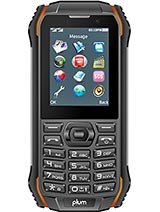
Plum Compass LTE
Experience the powerful features of Plum Compass LTE mobile phone. With a 5-inch display, 8MP camera and Android 7.0 OS, it's perfect for staying connected on the go. Get it now in black, gray, gold, rose gold, or white.
Smartphone Specifications and Features Summary:
Announced: 2017, November. Released 2018, January
Status: Discontinued
Display: 5.0 inches TN TFT
OS: Android 7.0 (Nougat)
Network: GSM / HSPA / LTE
Chipset: Mediatek MT6737M
CPU: Quad-core 1.3 GHz Cortex-A53
GPU: Mali-400
Memory: 8GB 1GB RAM
Battery: Li-Ion 2100 mAh
Available color(s): Black, Gray, Gold, Rose gold, White
The Rise and Fall of the Plum Compass LTE - A Budget Smartphone with Limited Features
In today's constantly evolving tech landscape, it's easy for budget smartphones to get lost in the shuffle. That was the case for the Plum Compass LTE, which was announced in 2017 but never gained traction in the highly competitive market. Despite its low price point and decent specs, the Compass LTE ultimately failed to make a lasting impact and was quietly discontinued just a year after its release.An Unimpressive Launch and a Quick Exit
The Plum Compass LTE was announced in November 2017 and released in January 2018, making its market debut during a time when budget smartphones were gaining popularity. However, the lack of marketing and buzz surrounding its launch may have contributed to its failure to gain traction with consumers. With bigger names dominating the market, the Compass LTE struggled to make an impact, and its limited release in select countries also hindered its potential success.A Budget Smartphone with Limited Features
One of the standout features of the Plum Compass LTE was its low price point, making it an attractive option for users on a budget. However, with a price tag that low, it also came with some compromises in terms of features. The operating system of the Compass LTE was Android 7.0 (Nougat), an already outdated version at the time of its launch. It was powered by the Mediatek MT6737M chipset and a quad-core 1.3 GHz Cortex-A53 CPU, which delivered decent performance for basic tasks but struggled with more intensive usage.In terms of memory, the Compass LTE offered 8GB of internal storage and only 1GB of RAM, which was far below the industry standard at the time. While it did have a microSD card slot for expandable storage, the limited internal storage and low RAM made it unsuitable for heavy usage or multitasking.
Underwhelming Display and Design
The Plum Compass LTE featured a 5.0-inch TN TFT display with a resolution of 480 x 854 pixels and a 16:9 aspect ratio. While it offered a decent viewing experience for everyday use, the low pixel density of 196 ppi and a screen-to-body ratio of just 64.1% were significant drawbacks. The overall design of the phone was also unimpressive, with a bulky body measuring 150 x 71.6 x 9.3 mm and weighing 146g. Its plastic build and basic color options (black, gray, gold, rose gold, and white) also gave it a cheap and dated appearance.Camera and Battery Performance
The Plum Compass LTE featured an 8 MP main camera with LED flash, which delivered mediocre image quality. Its video capabilities were also limited, with the maximum resolution of 720p at 30 frames per second. The front-facing camera was a 5 MP shooter, capable of only basic selfies and lacking video recording capabilities.In terms of battery life, the Compass LTE offered a 2100 mAh removable Li-Ion battery, which is below average for a smartphone. It provided up to 200 hours of standby time and up to 5 hours of talk time on 3G, which was adequate for basic use but not enough for heavy usage.
Cellphone Network and Connectivity
The Plum Compass LTE supported GSM, HSPA, and LTE cellular networks, offering decent data speeds of up to 42.2/5.76 Mbps on HSPA and 150/50 Mbps on LTE Cat4. It also featured Wi-Fi 802.11 b/g/n, Wi-Fi Direct, Bluetooth 4.0, GPS, and FM radio connectivity options. However, the lack of NFC capabilities and the use of the older microUSB 2.1 port were significant drawbacks.The Verdict
Undoubtedly, the Plum Compass LTE had its fair share of shortcomings, from dated specs to mediocre performance and underwhelming features. Unfortunately, it failed to make a lasting impact in the budget smartphone market and was quickly discontinued after its release. With more budget-friendly options offering better features and performance, the Plum Compass LTE just could not compete, and its limited availability also hindered its potential success. It serves as a cautionary tale of how quickly a smartphone can rise and fall in the ever-evolving tech landscape.Latest Plum Compass LTE Specs and Prices
LAUNCH
- Announced: 2017, November. Released 2018, January
- Status: Discontinued
PLATFORM
- Operating System: Android 7.0 (Nougat)
- Chipset: Mediatek MT6737M (28 nm)
- CPU: Quad-core 1.3 GHz Cortex-A53
- GPU: Mali-400
MEMORY
- Card slot: microSDHC
- Internal: 8GB 1GB RAM - eMMC 5.0
DISPLAY
- Type: TN TFT
- Size: 5.0 inches, 68.9 cm2 (~64.1% screen-to-body ratio)
- Resolution: 480 x 854 pixels, 16:9 ratio (~196 ppi density)
BODY
- Dimensions: 150 x 71.6 x 9.3 mm (5.91 x 2.82 x 0.37 in)
- Weight: 146 g (5.15 oz)
- SIM: Dual SIM (Micro-SIM, dual stand-by)
MAIN CAMERA
- Single: 8 MP
- Features: LED flash
- Video: 720p@30fps
SELFIE CAMERA
- Single: 5 MP
- Video: -
BATTERY
- Type: Li-Ion 2100 mAh, removable
- Stand by: Up to 200 h (3G)
- Talk time: Up to 5 h (3G)
CELLPHONE NETWORK
- Technology: GSM / HSPA / LTE
- 2G bands: GSM 850 / 900 / 1800 / 1900 - - SIM 1 & SIM 2
- 3G bands: HSDPA 850 / 1900 / 2100
- 4G bands: 2, 4, 5, 7, 17
- Speed: HSPA 42.2/5.76 Mbps, LTE Cat4 150/50 Mbps
SOUND
- Loudspeaker : Yes
- 3.5mm jack : Yes
COMMUNICATIONS
- WLAN: Wi-Fi 802.11 b/g/n, Wi-Fi Direct
- Bluetooth: 4.0, A2DP
- Positioning: GPS
- NFC: No
- Radio: FM radio
- USB: microUSB 2.1
FEATURES
- Sensors: Accelerometer
MISCELLANEOUS
- Colors: Black, Gray, Gold, Rose gold, White
Disclaimer: Specifications shown may be different from the actual product. We cannot guarantee that the information provided on this page is 100% correct. This content is provided for information purposes only. All information included herein is subject to change without notice.



















Leave your Opinion here